 |
|
|
|
Year 2018 - Volume 38, Number 6
|

|
Anaplasmataceae in cats (Felis catus) in the city of Campos dos Goytacazes, Rio de Janeiro, 38(6):1137-1150
|
ABSTRACT.- Pinto A.B.T., Paludo G.R., Gazêta G.S., Jardim M.P.B., Scalon M.C., Silva A.B. & Albernaz A.P. 2018. [Anaplasmataceae in cats (Felis catus) in the city of Campos dos Goytacazes, Rio de Janeiro.] Anaplasmataceae em gatos (Felis catus) no município de Campos dos Goytacazes, Rio de Janeiro. Pesquisa Veterinária Brasileira 38(6):1137-1150. Laboratório de Clínica e Cirurgia Animal, Hospital Veterinário, Universidade Estadual do Norte Fluminense Darcy Ribeiro, Av. Alberto Lamego 2000, Parque Califórnia, Campos dos Goytacazes, RJ 28013-602, Brazil. E-mail: andersonbtvet@gmail.com
In Brazil, by the year 2000, rickettsioses in domestic cats were little known and there were only sporadic reports of Ehrlichia sp. Recent research involving molecular biology and rickettsioses confirm the notion of the presence of theses agents in cats and show the need for more studies in Brazil. The objective of this paper was to characterize agents belonging to the Anaplasmataceae family that affect domestic cats and to clarify the importance of cats in the epidemiology of rickettsioses by molecular and serological methods associating the presence of disease with clinical and laboratory parameters. Blood samples were obtained from 60 healthy domestic cats. Blood count and serum biochemical tests were performed, and the data were registered. The samples were processed to obtain cell concentration and serum to perform the polymerase chain reaction (PCR) and the indirect immunofluorescence assay (IFA) respectively, in order to identify agents of the Anaplasmataceae family. The data were used for descriptive analysis to obtain frequencies and to perform non-parametric tests with the chi-square test (p≤5%), besides the laboratory findings of infection by Ehrlichia canis, Anaplasma phagocytophilum and Anaplasma platys. The results revealed that 33.33% of the agents belonged to the Anaplasmataceae family, 8.33% for E. canis, 20% for A. platys, and 10% for A. phagocytophilum. Serology samples were examined by indirect immunofluorescence to check samples reacting to A. phagocytophilum, with positive reaction of 8.33%. The most frequent clinical and laboratory findings in patients positive for Anaplasmataceae agents were lethargy, enlargement of lymph nodes, pale mucous membranes, dehydration, thrombocytopenia, hyperglobulinemia and hypoalbuminemia. These data had non-parametric correlation and the laboratory changes and presence of positive cats was not interdependent. Identification of E. canis and A. platys revealed the disease in the region of Campos dos Goytacazes/RJ. The presence of A. phagocytophilum is considered an important finding due to its zoonotic potential. |
| |
|
|
| |
|
 |